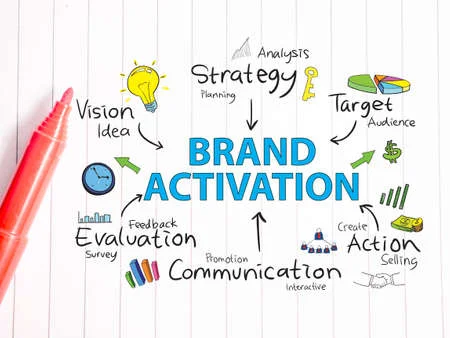Brands are everywhere. From the Dior logo to the Nike swoosh, brands promote goods, services, and even places. But exactly how to activate brand? Well, thankfully for you, this blog will give you some insight!
The first step is making sure that your company has a logo. A logo helps people identify your company among the competition. It also allows them to associate it with certain qualities, such as style or quality of service.
How to activate a brand???
If you have a start-up company, it’s time to start thinking about brand awareness. How do you go about promoting your company? If you are not sure how to activate your brand as a small business owner, then this blog will give you some great tips to get started!
The first step is figuring out the best way for your audience to engage with your brand. Next, you need a strategy that helps people learn more about who you are and what type of products or services they will be buying from you.
Think about what kind of social media channels you want to use. Do you want to use a blog? A Facebook page? Or maybe you would like to start a YouTube channel. Think about the brands that inspire and motivate your brand. Find out how they do it and see if there is a way for your brand to emulate them.
Brand Activation Strategy:
A brand strategy is a document that summarizes the purpose of a company and its goals. It says what products or services it will offer, who the target market is, and how it will differentiate itself from competitors. A brand activation strategy can mean something different for every business.
For example, when a retailer wants to market a product, they will develop a brand activation strategy to get their audience’s attention. To do this, they might host an event at a mall or retail store. This gives customers access to the latest trends and information about what is trending for the season. Your brand activation strategy will depend on the scope of your objectives, the resources you have available, your industry, category, etc.
It is important to remember that any strategy you implement should always be part of a more robust framework. So don’t lean on anyone’s strategy too much – focus instead on building a strong foundation for the myriad ways your brand can connect with key audiences. From there, launch various strategic initiatives, choosing one approach at a time based on the criteria listed below.
- Communication Strategy
- Community Engagement
- Vision idea
- Brand Activation plan
- Target audience
- Create Selling Actions
- Promote interactive communications
- Feedback Evaluation
Communication Strategy:
How will you communicate your brand messages? Social media is the go-to in today’s digital society, but remember to keep an open mind when considering other forms of creative expression. What are the things that are important to your brand and your audience? What would be the most effective way to express those ideas in print or on TV? For example, a company that makes high-end eyewear might focus on a specific customer segment that enjoys privacy and seeks luxury.
Community Engagement
Community engagement is a great way to create a dialogue with your customers, clients, and peers. It is a way to build a stronger connection between you and them. In addition, community engagement is a way to provide a meaningful purpose that will help and grow your audience and increase your user numbers. You’ll learn to align yourself with the best community engagement practices to establish a better connection with your audience.
The first and foremost reason for community engagement is to develop stronger relationships with your target audience. To engage your audience, you must have evidence of how valuable you are to them. You will be presenting value to them through this blog post.
Ever since the beginning of time, people have been asking themselves ‘why?’ Why do I exist? Who am I? What’s my purpose in life? It would be helpful if you addressed these questions to gain credibility with your consumers and build a strong connection.
There are several things to consider when designing a brand activation strategy, such as:
- How much is your company outlay?
- What is the goal of the campaign?
- Who do you want to target?
- Where will you be hosting your event?
Various brand activation strategies include vision, idea, brand activation plan, target audience, creating action selling, promoting communication, valuable feedback, collaboration, etc.
Vision Idea:
A brand should have a clear and unified vision. It should be to provide products or services that can satisfy the needs of consumers and allow them to feel happy and satisfied with the product or service. For example, Apple’s vision is “to leave the world better than we found it.” In this case, as long as Apple can create popular products that people love, they are fulfilling their vision.
Brand Activation Plan:
Brands today are looking for ways to integrate with their customers on a more intimate level. This is where brand activation comes into play.
Brand activation is an interactive tool that allows consumers to be engaged with the brands they love in a social environment. It is not only an opportunity for brands to reach consumers, but it’s also important because consumers now expect immediacy and interactivity with the brands they buy from, especially online.
A brand activation plan helps you turn your idea into a reality. It is a plan that can help you implement your thoughts from the ground up. This plan will involve your site, social media profiles, and events to create momentum for your brand. It also has a budget for the first phase of this success, which might require an investment in advertising or marketing. The idea is to make a great product or service and market it worldwide.
Target Audience:
The third most important step in brand activation strategy is the target audience. It’s essential to have a target audience when marketing because there are countless products in the world for different people, so it’s necessary to figure out which group you want your product marketed towards.
To start, you should identify your niche brand. This is the specific type of person or culture you are trying to reach with your marketing plan.
Create Action Selling:
In a world where people do what they want, not what they are told, the only way to stay competitive is to be different. You have to inspire your customers with products that are worth standing in line for and services that are worth waiting for. Fortunately, there is a way out of this dilemma: creating action selling.
“Create action selling” is a social media marketing technique that has taken the world by storm! It’s a powerful yet simple solution to help grow your social media following and engagement on Instagram.
Promote Interactive Communication:
We interact with people every day and think of our communication as pleasant interactions. However, we often don’t know what to say, which leads to awkward silences or miscommunication that negatively impacts the interaction.
The definition of communication is to transmit information over a distance. Promoting communication is sharing ideas, products, services, and visions with customers. Brand strategy must be communicated throughout an organization as different teams have different perspectives. The brand strategist’s job is to maintain and articulate the brand vision and ensure successful communication with all staff members.
Feedback Evaluation:
Brands have to reduce their ideas to a few key competitive advantages in the strategy process. Those are then taken through a process of evaluating and refining to produce a coherent range of brand assets for marketing purposes. This final design will define the brand going forward, and it’s vitally important that all stakeholders in this process have an opportunity to comment on it.






